在这篇文章中,我们将看到如何将复杂的JSON实体反序列化为已有的Java对象。我们将看到怎么使用GSON的deserialiser,以控制JSON实体映射到Java对象。
一、 前言
请注意,在这篇文章中我们将使用术语解析或反序列化。
下面列出的所有代码均放在: https://java-creed-examples.googlecode.com/svn/gson/Gson Deserialiser Example。
二、 简单例子
比方说,我们有以下的JSON实体
上述JSON包括四个字段,其中之一是一个数组。这些字段代表我们的书。默认情况下,GSON希望在Java中的变量名跟JSON中是一样的。因此,我们应该创建具有如下字段名的类:title,isbn-10,isbn-13和authors。但在Java中,变量名不能包含减号。
那怎么解决上面的问题呢?
一种方法就是使用注解:注释提供了较少的控制,但更简单的使用和理解。也就是说,注释其局限性太大,不能满足这里描述的所有问题。
另一种方法就是使用 JsonDeserializer,使用它我们可以完全控制Json实体怎么被解析。
看如下的Java类
此Java对象将被用来保存在前面显示的JSON实体列出的书。这两个对象(Java和JSON)的结构是在本例中相同,但是这不是必需的。
为了能够解析JSON到Java,我们需要创建实现 JsonDeserializer 接口的类。下面的例子显示了我们实现的 JsonDeserializer 类。
上面的代码是不完整的,我们还需要增加其他的处理,先让我们来解释下这些代码。
接口 JsonDeserializer 是一个泛型,接收一个类型,就是我们的目的解析对象的类型。在这个例子中就是Book。该接口的方法 deserialize() 方法也必须返回同样类型的对象。
GSON将JSON实体解析为 JsonElement 类型的Java对象。JsonElement 实例可以是下列之一:
- JsonPrimitive - 如字符串或整数
- JsonObject -
JsonElement对象的集合,索引就是它们的名称(类型String)。类似于Map<String, JsonElement> - JsonArray -
JsonElement对象的集合。该集合中的元素可以是任意的JsonElement类型对象。 - JsonNull - 一个null值
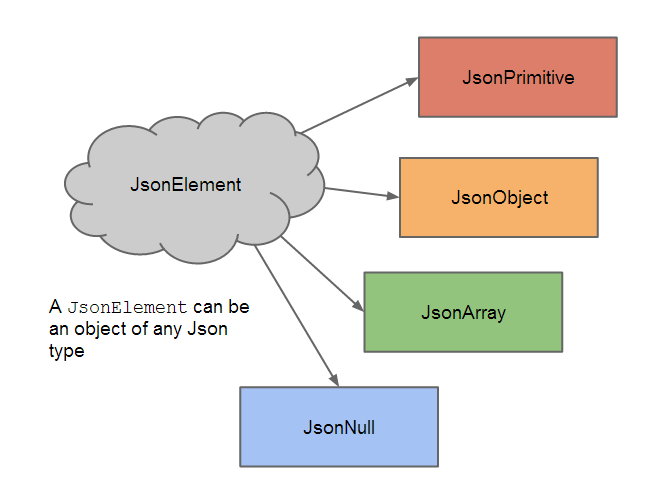
上图为 JsonElement 的类型图
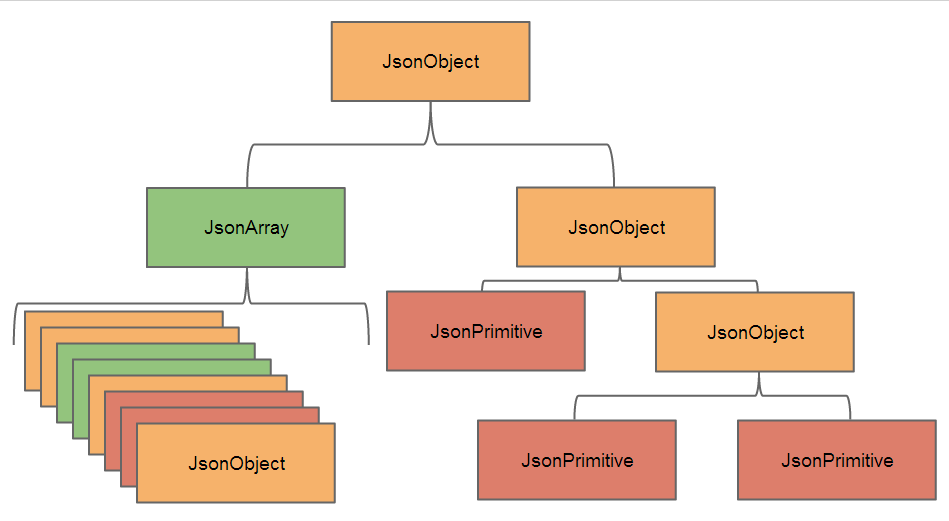
上图为 JsonObject 的嵌套结构图
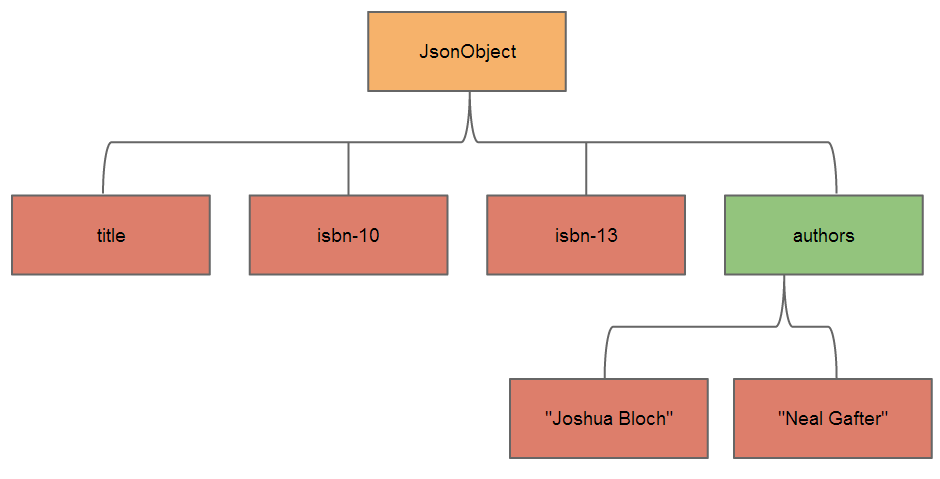
上图为 Book例子中的 JsonObject 结构图
如果我们要反序列化此JSON实体,我们首先需要将JSON实体转换成 JsonObject ,如下所示。
一个JSON实体能够转换为上述中的任何一种类型。
可以通过JSON实体中的字段名称检索出该字段值
该方法返回的是 JsonElement 类型对象,可以通过如下方法将其转换为 String 对象
下面的代码完整的演示了自定义反序列化类 BookDeserializer
为了自定义JSON实体的解析,还需要先指定(注册)目的解析对象的自定义反序列化类,如下所示。
自定义解析JSON实体的内部原理一般为如下:
1、将输入的JSON实体解析为 JsonElement 类型的Java对象
2、找到目的解析对象的反序列化类,这个例子中就是 BookDeserializer
3、调用 deserialize() 方法,并返回目的解析对象
4、将deserialize() 方法的返回结果作为 fromJson() 方法的返回结果
上述例子的结果输出为:
三、 嵌套对象
现在让我们扩展上面的例子,将JSON实体嵌套如下:
该JSON实体对应的 JsonObject 结构图如下:
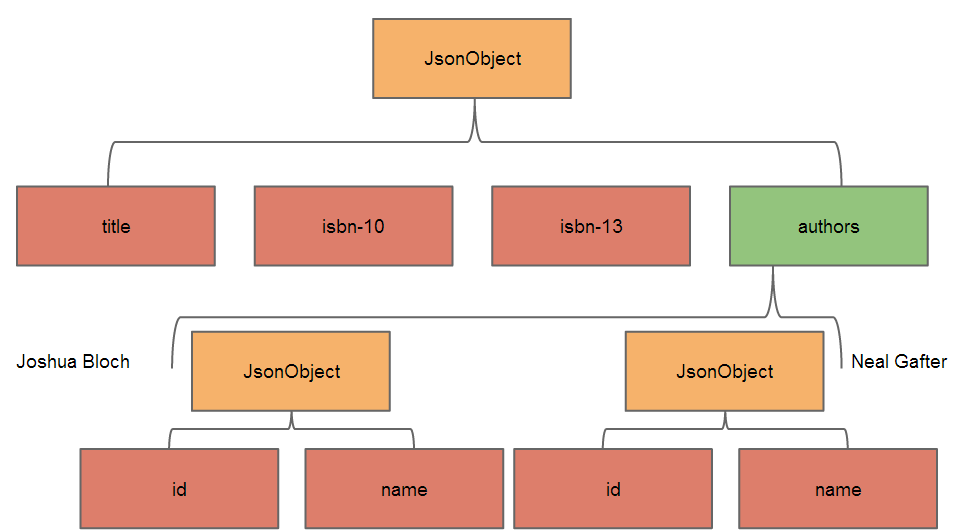
因为Book嵌套author这样一个JSON实体,所以我们需要新增一个author类来表示该author实体,并且Book类需要关联该author类。
问题就来了:我们应该怎么反序列化出author类。
有如下几个解决方案:
1、直接在 BookDeserializer 增加author的反序列化代码。但是这对于程序的扩展很不好,因此不推荐。
2、我们可以使用默认的GSON实现,因为该例中author类的实例变量和author实体字段具有相同的名称,因此可以使用默认的GSON解析。
3、我们可以再写一个 AuthorDeserializer 类,将author的反序列化独立出来。
第二种方案的实现
先说下GSON中 JsonDeserializer 上下文
在 JsonDeserializer 接口的 deserialize() 方法中,提供了参数 JsonDeserializationContext。我们可以将对象的反序列化委托给 JsonDeserializationContext 实例,如下所示。
完整的代码如下所示。
第三种方案的实现
自定义author实体的反序列化类 AuthorDeserializer 如下所示:
为了使用 ArthurDeserialiser,我们也需要像之前Book一样进行注册,如下所示
该例子输出如下所示:
四、 对象引用
请看下面的JSON。
上面所示的JSON实体包括两个author和两本book。其中book通过author的id对author进行引用。这是一个相当常见的情况,因为这种方法会降低JSON实体的大小。下图为该JSON实体的 JsonObject 结构图
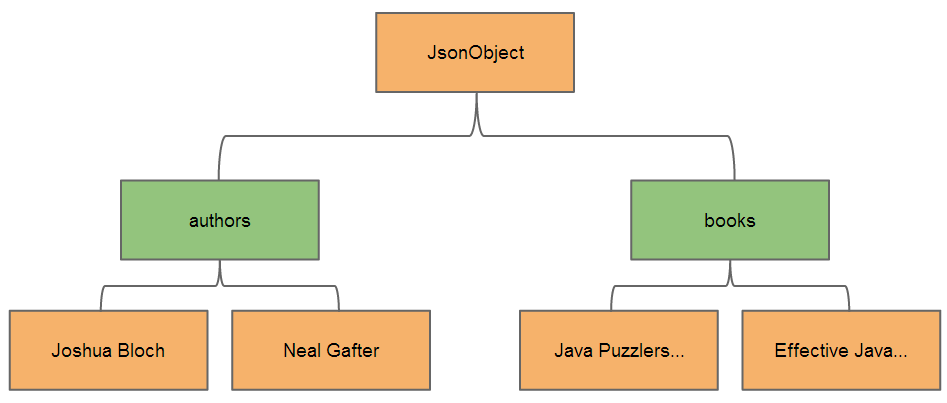
这种新的JSON实体结构中引入了新的挑战:当反序列化book时,我们需要持有从JSON实体层次的其他分支反序列化出的author。
有很多种方案可以解决这个问题,下面只介绍一种
具体方案为:AuthorDeserialiser 作为反序列出的作者的缓存,返回下一次过来的id请求。这种方法的优势在于它利用了 JsonDeserializationContext,并使关系变得透明。不幸的是,它因为需要处理缓存而增加了复杂性。
下面介绍下具体实现
由于该JSON实体包含两个数组,故我们需要定义一个新的类来映射该JSON实体
字段顺序决定了谁先被反序列化,但是这在我们这个例子中是没有关系的。
AuthorDeserialiser 需要被修改,使得它缓存反序列化出来的author。
下面让我们来一个个讲解这个类的变更
1、author被缓存在如下的对象中
它使用 Map<String, Object> 作为缓存机制。该map被保存一个 ThreadLocal 实例中。因此该类允许多个线程使用相同的变量,而不受其他线程的干扰。
2、author总是使用如下的方式进行检索
3、deserialize()方法也将做如下的修改descerialiser 可以接收 JsonPrimitive 或 JsonObject 参数。当 BookDeserialiser 执行以下代码时,传递给 AuthorDeserialiser 的 JsonElement 将是 JsonPrimitive 的一个实例。
逻辑图如下:
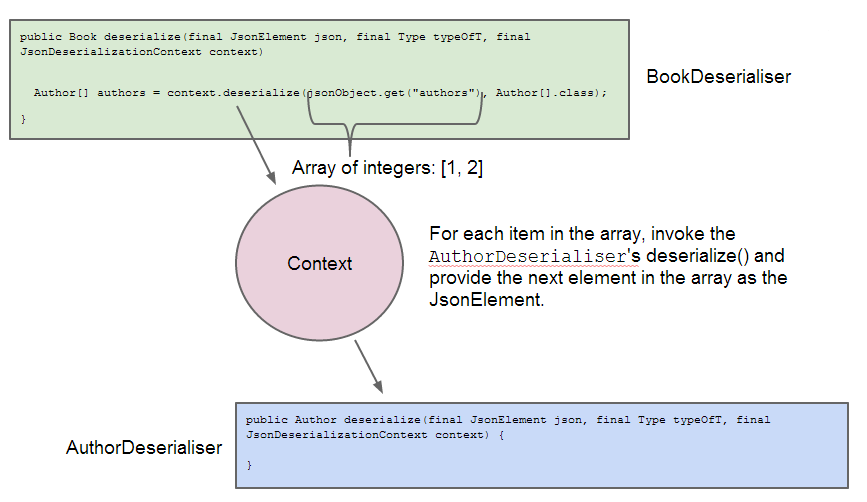
BookDeserialiser 使用 context 代理author的反序列化,并提供了一个整形数组。对于该数组的每一个元素,该 context 都将调用下 AuthorDeserialiser 的 deserialize() 方法,并将该整形元素作为 JsonPrimitive 传递给方法。
另一个方面,当author被反序列化时,我们将得到一个包含author元素的 JsonObject。因此,在我们转换给定的 JsonElement 之前,我们需要确定它是否是正确的类型。
在上面的例子中,只有id可用。 JsonElement 被转换为 JsonPrimitive,然后转换为int。该int用于从 getOrCreate() 方法中检索作者。
JsonElement可以是JsonObject类型,如下所示。
在这种情况下,在返回作者之前,该名称将添加到由 getOrCreate() 方法返回的作者实例中。
最后,如果给定的 JsonElement 实例既不是 JsonPrimitive 也不是 JsonObject,将抛出异常。

